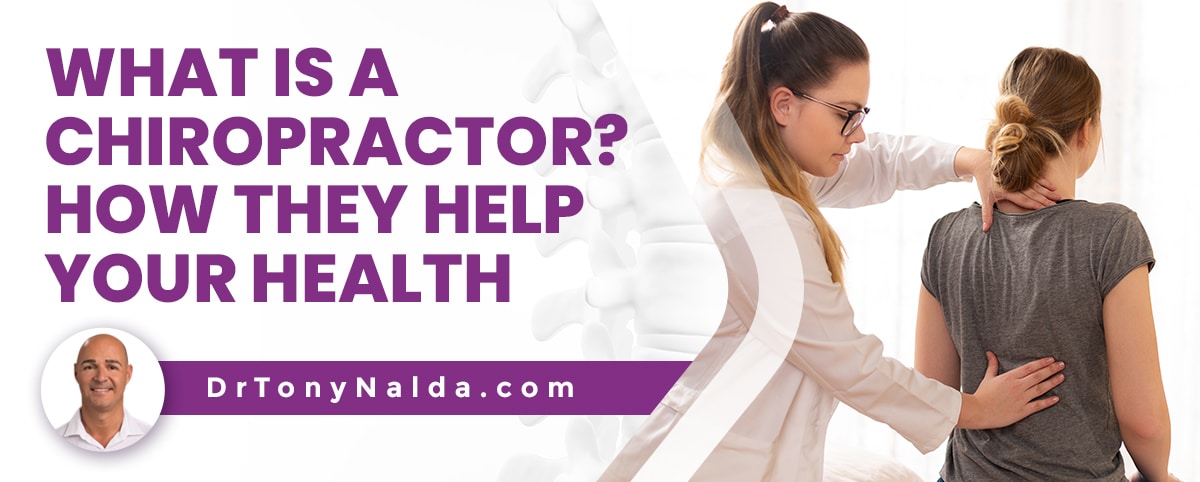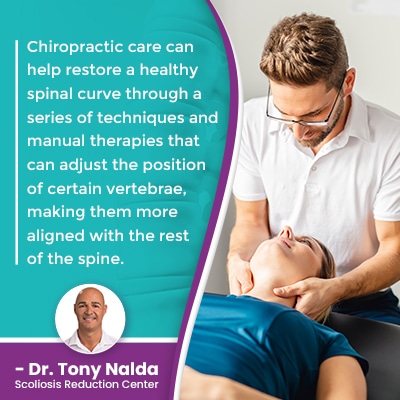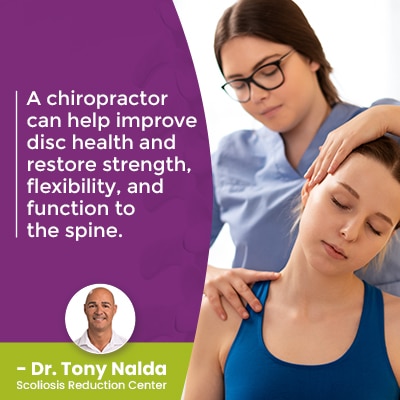What Is a Chiropractor? How They Help Your Health

The spine is a long complex structure with many moveable parts. A healthy spine helps maintain good posture, flexibility, and a healthy range of movement. Chiropractic care can help keep the spine flexible and aligned, and when chiropractic care helps restore healthy spinal curves, it can address a number of spinal conditions and issues that can affect a person's overall health.
A chiropractor uses a variety of techniques and manual adjustments to address issues with bones, joints, and muscles, so can help address a number of spinal issues/conditions. With complex structural spinal conditions like scoliosis, chiropractic care has to be scoliosis-specific.
A chiropractor can help keep the spine healthy which can help overall health in a number of ways.
Table of Contents
A Healthy Spine
A healthy spine allows us to stand upright, practice good posture, engage in a wide range of movements such as bending, lifting, and twisting, and protects important organs.
The spine also works in tandem with the brain to form the body's central nervous system (CNS) that facilitates brain-body communication, so the spine is involved in the function of virtually every working part and system within the body.
The spine contains 31 pairs of spinal nerves that exit the spine and branch out to different parts of the body, impacting both movement and sensation.
A healthy spine will look like an 'S' when viewed from either the left or right side and will appear straight when viewed from the front and/or back; this is due to the spine's healthy curves in each of the spine's main sections.
The main spinal sections consist of the cervical spine (neck), the thoracic spine (middle/upper back), and the lumbar spine (lower back), and each has a characteristic curvature type helps the spine stay strong, healthy, flexible, and able to handle mechanical stress from movement and impact.
A chiropractor specializes in bone, joint, and muscle health; the spine's curves and alignment need to be supported by healthy muscles, so chiropractic care can help adjust the position of the vertebrae (bones of the spine) and improve the spine's surrounding muscle strength for optimal support and stability.
Chiropractic Care and Healthy Spinal Curves
A spine with its healthy curves in place is a spine that has its vertebrae aligned in a straight and neutral position.
The spine has different curvature types; for example, lordosis refers to the spine bending inwards, towards the body's center, and kyphosis is a backward-bending spinal curve that bends away from the body's center.
If the spine loses a single healthy curve, it doesn't just affect the spinal section it develops in, but the entire spine as its entire biomechanics are disrupted.
A spine with an unhealthy curve is one that's misaligned so isn't going to be as strong, flexible, or able to absorb and distribute mechanical stress evenly throughout the spine.
So if a chiropractor can help restore a healthy spinal curve, it can help the spine function as it was intended.
 Chiropractic care can help restore a healthy spinal curve through a series of techniques and manual therapies that can adjust the position of certain vertebrae, making them more aligned with the rest of the spine.
Chiropractic care can help restore a healthy spinal curve through a series of techniques and manual therapies that can adjust the position of certain vertebrae, making them more aligned with the rest of the spine.
Chiropractic manipulation can impact the position of a vertebral body, and this doesn't just affect the spine itself, but also the spine's surroundings: the musculoskeletal system.
Spinal manipulation therapy can be applied to address a number of spinal conditions/issues and can help with sports injuries, relieve neck pain, back and neck pain, joint pain, chronic low back pain, joint mobility, a mild headache to migraines and more.
Physical Therapy and Chiropractic Care
When it comes to structural spinal conditions that cause a loss of healthy spinal curves and alignment, it's important that structural changes within the spine are properly supported and stabilized by strong surrounding muscles.
Physical therapy can help increase the strength and balance of the spine's surrounding muscles; a strong musculoskeletal system is one that can withstand the stresses of movement, impact, and one that won't be as vulnerable to injury and degenerative changes.
Most chiropractors work closely with physical therapists and can offer referrals.
Integrative health care professionals combine the power of complementary treatment disciplines like physical therapy and chiropractic care.
As the spine's healthy curves are so important, what's a condition that's known to cause the development of an unhealthy spinal curve?
Scoliosis and Chiropractic Care
Scoliosis causes the development of an unhealthy spinal curve that bends to the side and rotates, and the rotational component makes scoliosis a 3-dimensional spinal condition.
Scoliosis is progressive, so its nature is to get worse over time, and while we don't always know what causes scoliosis to develop initially, we know it's growth that makes it progress.
A condition like scoliosis introduces a lot of uneven forces to the spine, its surroundings, and the entire body.
As the uneven forces increase with progression, so do their effects, and in children, the main scoliosis symptoms involve postural changes, and the main symptom in adults is pain; scoliosis becomes a compressive condition once skeletal maturity has been reached.
Chiropractic care can help with pain management made necessary for a number of reasons, and when it comes to scoliosis pain, we're talking about pain caused by uneven pressure.
Scoliosis pain management can include chiropractic care that maintains spinal flexibility, counteracts compression, and increasing condition effects through curvature reductions.
A structural spinal condition has to be primarily impacted on a structural level with chiropractic care, spinal manipulation; a spinal manipulation can improve the spine's alignment and restore as much of the spine's healthy curves as possible.
Spinal Discs and Chiropractic Care
The spine consists of vertebrae stacked on top of one another in a straight and neutral alignment, and adjacent vertebrae are separated by an intervertebral disc.
The discs serve important purposes; they give the spine structure (adjacent vertebrae are attached to the disc in between), flexibility, and act as the spine's shock absorbers.
If the spine is being compressed, so are its individual parts and its surroundings, and this includes the discs, which can lead to uneven wear and tear and spinal degeneration.
Once a disc is wearing unevenly and experiencing degenerative changes, it can change shape and disrupt its ability to maintain its natural curves, alignment, strength, and flexibility.
A degenerating disc can become a bulging disc that leads to disc herniation; chiropractors can help by relieving pressure on the spinal discs; once a disc starts to degenerate, it can be difficult to reverse as the discs are the largest structures inside the body without their own vascular supply.
Degenerative disc disease is a contributing factor in the development of a number of spinal conditions
The intervertebral discs have no direct path into and out of the discs through which blood and nutrients can pass and waste can be eliminated; discs absorb what they need from their surroundings through a process similar to osmosis.
 A chiropractor can help improve disc health and restore strength, flexibility, and function to the spine.
A chiropractor can help improve disc health and restore strength, flexibility, and function to the spine.
Headaches and Chiropractic Care
Chiropractic care can help with headaches and migraines by reducing tension in the cervical spine; this can involve spinal manipulation, a variety of therapies and treatment modalities, and lifestyle advice.
As the spine and brain form the central nervous system, health care professionals that specialize in spinal health, can also preserve brain-body communication, and an unnatural spinal curve is also associated with irregularities in the flow and levels of cerebrospinal fluid in and around the spine and brain.
CSF cushions and protects the brain and an unnatural spinal curve can disrupt the flow between the brain and spine, causing headaches that can reach migraine status, so manual therapy and other treatments can also improve CSF levels and headaches.
So a healthy spine supports the body's natural ability to move, communicate, and maintain its overall strength and health.
Conclusion
Here at the Scoliosis Reduction Center®, I've been treating scoliosis, and a variety of other spinal conditions and issues, for over 20 years.
My interest in chiropractic started because of my own issues with migraines disrupting life as an adolescent; I had tried everything, and it wasn't until I was treated by a chiropractor that my migraines improved and I could return to sports.
As a scoliosis chiropractor, I know the spine and I know how scoliosis affects it. I know how important a healthy spine is to overall health and wellness, and there are a variety of conditions that can affect it and disrupt a person's quality of life.
When it comes to general chiropractic care, spinal flexibility and range of motion can be improved, and when it comes to scoliosis-specific chiropractic treatment, we're talking about a variety of techniques and manual therapies that can realign the spine and reduce unnatural scoliotic curves.
Chiropractic is based on scientific research on spinal function and manipulation, and many chiropractors can improve a number of medical conditions.
Chiropractic care can also be preventative and is considered an alternative medicine that can help many people avoid the need for surgical treatment.
Diagnostic imaging can help me see what's really happening in and around the spine, and this can help diagnose a number of conditions and lead to the crafting of effective treatment plans.
Dr. Tony Nalda
DOCTOR OF CHIROPRACTIC
After receiving an undergraduate degree in psychology and his Doctorate of Chiropractic from Life University, Dr. Nalda settled in Celebration, Florida and proceeded to build one of Central Florida’s most successful chiropractic clinics.
His experience with patients suffering from scoliosis, and the confusion and frustration they faced, led him to seek a specialty in scoliosis care. In 2006 he completed his Intensive Care Certification from CLEAR Institute, a leading scoliosis educational and certification center.
About Dr. Tony Nalda
 Ready to explore scoliosis treatment? Contact Us Now
Ready to explore scoliosis treatment? Contact Us Now





